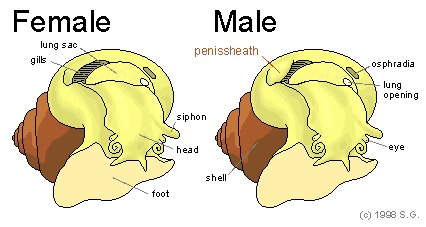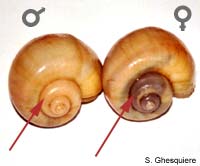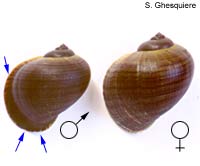
| Reproductive system |
|
Overview 3D anatomy Digestion Senses Nerves Respiration Circulation Reproduction Other Shell |
The apple snail has separated sexes (dioecious) and is NOT a hermaphroditic
snail.
The differences between the sexes are not visible at the shell
colour or patterns, but in several species, a difference in shell shape has
been described. For example in Pomacea canaliculata,
the aperture (opening) in the male has a rounder opening
than in the female because of the large penial complex.
This sex-difference is not very well visible and it's not a very reliable to
dicriminate on individual base, but clear when measuring large amount of snails
(in other words, it's possible to show the difference based on statistics).
In some species however, the difference between male and female are very obvious
in the adult snails. For example in Pomacea flagellata
flagellata, the male has a very wide shell lip (the shell opening actually
has the shape of a trumpet) when reaching sexual maturity. This hasn't been
described in the literature yet (october 2000), but the author of this site
has observed this in his entire Flagellata population. This shell shape
difference cannot be explained by the space occupied by the penial complex,
but is rather a reproduction strategy: the male can block the entrance of the
female's mantle cavity during mating, in order to prevent other males from copulating
with the female. Note that this is only a hypothesis of the author.
No serious scientific research has been carried out on this topic.

Despite the shape difference, it often easier to determine
the sex by looking inside the mantle cavity to spot the penial complex or the
absence thereof in case of a female snail. To do this one should take the snail
out of the water and keep it upside down for a minute or 10 and blow some fresh
air over the snails body. The animal will (hopefully) stretch its foot out to
turn the shell upright. When this happens it's possible to look inside the right
mantle cavity, where one should look for the relatively large penissheath in
front of the gills. The female snail lack
such structure (obvious). The picture above should help to see the difference
between the sexes.
Last, but not least: in very thin shelled apple snails and in specimen with
translucent shell (albino Pomacea diffusa),
one can also observe a colour difference in the upper whorl (spine) of the shell
in periods that the snails are in a reproduction stage. The female ovaria can
then show up as a dark organ at that place (see picture below). Note however,
that this method is not reliable at all times and can only be used when the
snail are sexual active. In the latter case the snails mate anyway, so that
one can see the male snail mounting the female repeatedly.
A sex change from male to female (proandry) has been described for some Pila
and Pomacea apple snails. In case of Pila
snails, the male needs a preparatory aestivation period to become a female,
while the Pomacea snails can change sex at all times (at least in certain
species). During this sex change, the testis change in colour and decrease in
size. The frequency at which this sex change occurs is not certain and not much
literature is available about this subject. There is some very interesting research
about the effects of certain chemical substances that are known of suspected
to have influence on the development of the reproductive organs. Many of these
substances are of great concern as they can be found in habitats due to pollution.
Check
here for an interesting research page about this subject (in German).
 When snails with a tranlucent shell (albino Pomacea diffusa in this case) are ready to reproduce, the ovaria of the female (left) can become suspicious through the shell. |
 Marisa cornuarietis is not selective when it comes to a mating partner and mounts other species as well (in this case a Pomacea flagellata snail). |
 Sex differences in adult Pomacea flagellata flagellata snails. The female is larger and has a straight shell opening, while the male (left) has a extended shell lip. |
Sex ratio
The sex ratio within apple snail populations is around 0.5, which means that
there is an equal amount of males and females. However, the sex ratio between
the broods of a population varies a lot. Some egg masses give almost exclusively
male hatchlings, while other give exclusively female offspring. It was first
thought that environmental factors influence the sex ratio in apple snails.
For example the temperature could determine of the snail become male or female,
like is the case for crocodiles.
Recent research (Yusa &
Suzuki, 2003) shows that the sex ratio is likely genetical determined.
It turns out that different spawns of a single mating pair shows little variation
in sex ratio between the different broods, despite variations in environmental
circumstances. This supports a genetic basis for sex determination.
In humans, the sex of an individual is determined by the X and the Y chromosomes
(XX= female, XY= male). However, there is no clear evidence for the presence
of X and Y chromosomes in apple snails. Most likely, apple snails have a different
sex determining system, in which sex is determined by a number of genes (polyfactorial
sex determination). The combination of at least three and most likely more genes
determine the sex ratio. Future research will hopefully give a better insight
in the sex determining mechanisms.
 |
Male reproductive system
The male reproductive tract consist of the testis and vas deferens, the seminal
vesicle and the prostate gland, the penial sac, the penis and the penis sheath.
The cream-yellow testis can be found in the upper part (1.5 to 2.5 coils)
of the shell along the dark coloured digestive
gland. The short tubules (vasa efferentia) inside the testis fuse to form
the vas deferens.
The vas deferens passes down to the seminal vesicle, beneath the kidney
chamber. In this seminal vesicle, the sperm cells are stored.
The prostate gland is closely connected with the seminal vesicle and
is situated next to the seminal vesicle (they appear as one structure from the
outside). The prostate gland passes down the right margin of the mantle skirt,
along the rectum and ends in the penial papilla, next to the anal papilla at
the roof of the right mantle cavity.
During mating activities, this penial papilla
bends towards the sperm groove in which the sperm is conducted. From
this sperm groove the sperm is conveyed in the penial duct at the base of the
penis.
The penis itself is coiled in a basal pouch (penial sac) when
not used. On erection the penis comes out of the penial sac and is grasped around
on the lower thirth by a muscular penial sheath from the mantle. It's
the latter, which can be seen when the snails are mating. The real penis is
rather thin, whip-like and often stays out of sight.
|
In the sperm cell production in Pomacea canaliculata
and perhaps also all other members of the Ampullariidae family, two types of
sperms are produced: eupyrene sperm, or normal, viable sperms cells, and apyrene
parasperm. This latter type of sperm consists of sterile cells, which are the
result of a complex cytodifferentiation process, in which they develop into
anuclear ciliated cells, completely different from the normal sperm cells. The
apyrene paraspermatozoa (sperm cells) are filled with secretory granules, rich
in glycoproteins (an energy rich protein molecule).
The function of these sterile sperms cells is not fully understood, but several
possible functions are proposed. In one hypothesis, the package of normal sperm
cells (euspermatozoa) with these sterile (apyrene paraspermatozoa) cells into
large motile units, is considered as a solution to penetrate the sperm plug
left inside the female to block access for sperms of concurrent males.
Providing nutrition for the functional (eupyrene) sperm cells, could be another
function of the apyrene sperm cells. According to this viewpoint, the apyrene
sperm cells support the normal sperm cell in their travel trough the female
reproductive tract by releasing their glycoproteins. These glycoproteins are
an important energy source for the moving sperm cells.
The production of an egg in Pomacea: |
Female reproductive system
The egg cells of the female snail are stored in the ovaria, which are
located in the top of the spine, closely to the digestive
gland.
To produce an egg, the egg cell is brought to the receptaculum seminis.
In this place, where the sperm from the male is stored, the fertilisation of
the egg cells takes place. The spermatozoa (sperm cells) of the male can survive
for more than a month in the female, and several egg
clutches can be fertilised with a single copulation.
The albumen (yolk) from which the snail embryo is living is added by the proximal
albumen gland and further during its way through the eggs tube by the distal
albumen gland. These glands increase considerably when the female is about
to produce eggs. And while the ovaria are located in the top of the shell,
the albumen glands are located in the top of the mantle
cavity and in the reproductional season they move closer to the shell opening
and can even fill a large part of the right mantle cavity.
| Microscopic images: - detail of the albumen gland (Pomacea canaliculata) (64k) |
On its way to the shell gland, where the calcareous outside of the
egg is added (for the species that lay their eggs above the waterline), the
egg is passes through the pseudo-bursa copulatrix. In this bursa the
sperms of the male are received and the defect or incomplete sperm cell that
aren't able to swim towards the receptaculum seminis, are absorbed here.
At the end of the egg tube, the egg is finished and leaves the genital
tract at the gonopore.
| Movies (MPEG1): - Egg deposition (Pomacea diffusa) (267kb) |
The apple snail species from the genera Pila
and Pomacea deposit their eggs above the
waterline. They are guided to the egg clutch in an ovipositor groove over the
snail's body. This groove lays on top of a swollen part of the foot, which is
formed by inflating the tissue below with fluid. The ovipositor structure is,
as result of this, visible as a semi-transparant lump on the snails body. Note
however, that not all apple snails exhibit such visible structure when depositing
their eggs. One of the species which has a good visible ovipositor structure
is Pomacea diffusa.
To get a better idea about the eggs deposition, watch this mpeg movie of a Pomacea
diffusa snail depositing her eggs: [egg_laying_movie]
(267kb). Note that the speed of the movie has been increased (25 times real
time).
The eggs of the species that deposit their eggs above the waterline are soft
when they appear from the snails body, but the eggshell hardens within a few
hours after they are laid.
|
Interactive 3D-models (Java): |
However not all apple snail lay their eggs above the waterline: the snails
from the genera Asolene, Lanistes,
Marisa and possibly also Afropomus
and Saulea (anyone info about this?) lay
their eggs in the water, embedded in a gelatinous mass. These eggs are relatively
small when they are laid, but take up a lot of water within the first hours
after being laid and thus swell significant.
The rate of which the eggs are laid is about 1 every 30 seconds in Pomacea
canaliculata and Pomacea
diffusa.
|
|
|
|
|
Except where otherwise noted, this page is licensed under a Creative Commons Attribution-NonCommercial-ShareAlike 2.5 License . http://www.applesnail.net |
|